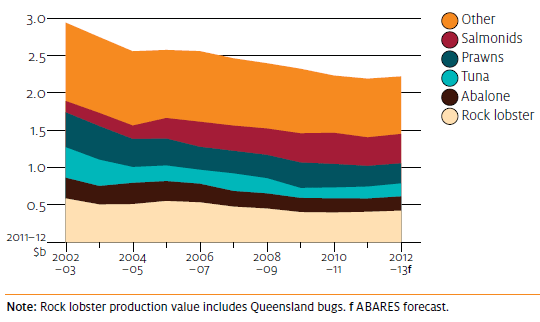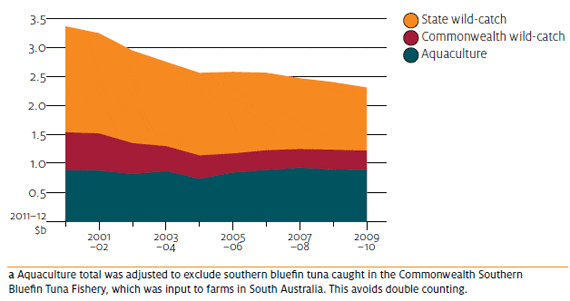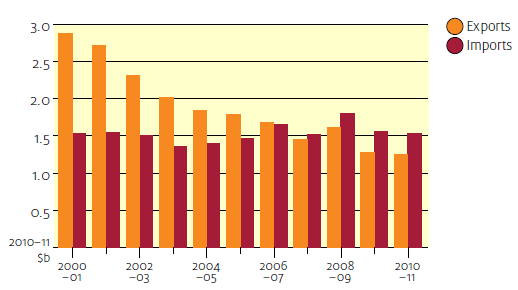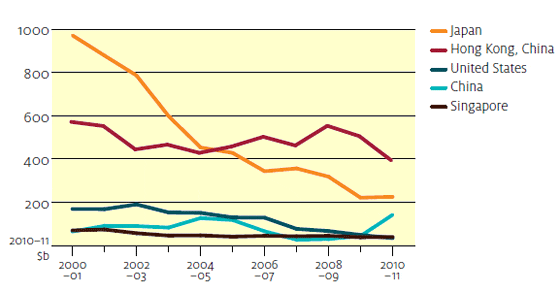Fisheries production growth projected for the outlook period
The real value of Australian fisheries production has declined significantly over the past decade, attributable to a decrease in the value of production of some higher value species groups, such as rock lobster, prawns, abalone and tuna. However, over the past five years, the pace of decline has slowed, primarily reflecting growth in farmed salmonids production, which partly offset continued declines in the wild-catch sector. Over the outlook period to 2016–17 the real value of Australian fisheries production is projected to remain steady at around 2.2 billion.
Australia’s fisheries resources and production
In 2009–10, Australia’s gross value of fisheries production was $2.2 billion, 0.8 per cent lower than in the previous year. This is the lowest gross value of production in over a decade, having fallen by 31 per cent ($1057.3 million) in real terms since 2000–01 (in 2011–12 dollars). Most of the decline occurred between 2000–01 and 2004–05, when gross value of production fell on average by 7 per cent a year; and between 2004–05 and 2009–10 when the value fell on average by 2 per cent a year.
The product composition of the gross value of production of Australian fisheries has not changed substantially over the past few years. The top five species groups (by value) comprise salmonids, rock lobster, prawns, abalone and tuna. Rock lobster has frequently ranked as Australia’s most valuable species group over the past decade. However, salmonids surpassed rock lobster to be Australia’s most valuable species group in 2009–10 at $369.1 million, representing 17 per cent of the gross value of fisheries production. This was followed by rock lobster ($368.8 million, 17 per cent), prawns ($324.1 million, 15 per cent), abalone ($180.3 million, 8 per cent) and tuna ($125.3 million, 6 per cent).
Australia’s Fisheries Production, Volume and Value in 2009–10

Real Value of Australian Fisheries Production, by Key Species Group

The wild-catch sector
In 2000–01, the wild-catch sector accounted for around 74 per cent of Australia’s gross value of production from fisheries products. Of this, state fisheries (generally classified as fisheries adjacent to each state and/or territory within three nautical miles of the coastline) accounted for 74 per cent. The remaining 26 per cent was from Commonwealth fisheries (defined as up to 200 nautical miles from the coastline—the Australian Fishing Zone). In 2009–10, the wild-catch share of Australia’s fisheries gross value of production had declined to 62 per cent, reflecting a decline in the value of catches from both state and Commonwealth fisheries.
In value terms, the largest jurisdiction in the wild-catch sector in 2009–10 was Western Australia, accounting for 26 per cent ($271.9 million) of the total value of wild-catch from state fisheries. This represented a 7 per cent decline in the gross value of production, which mainly reflected decreases in the volumes of rock lobster, abalone and scallops, as these species groups accounted for 74 per cent of the total value of the state’s wild-catch production in 2009–10.
The aquaculture sector
Over the past decade, the real gross value of production of Australia’s aquaculture sector has declined by 4 per cent to $923 million in 2009–10 (in 2011–12 dollars). Most of the decline occurred in the early part of the decade, with the sector growing by 18 per cent since 2004–05. The slower pace of decline compared with the wildcatch sector has resulted in the aquaculture share of total fisheries value increasing from 26 per cent in 2000–01 to 38 per cent in 2009–10.
The largest contributor to Australian aquaculture production is salmonids, making up 43 per cent and 42 per cent of the total aquaculture production volume and value, respectively. Since 2004–05, the real value of Australian farmed salmonids production increased by 117 per cent ($210.9 million) to $391.5 million in 2009–10 (2011–12 dollars). This is supported strongly by rapid growth in Tasmanian aquaculture production.
Farmed tuna production consists solely of farmed southern bluefin tuna from South Australia, which accounted for 12 per cent ($102.2 million) of the total value of Australian aquaculture production in 2009–10. The farming of southern bluefin tuna involves transferring juvenile fish caught in the Commonwealth Southern Bluefin Tuna Fishery to farms in South Australia for maturation and fattening.
Aquaculture prawn production was valued at $77.4 million in 2009–10, representing around 9 per cent of the total value of aquaculture production in the year, and a 36 per cent ($20.6 million) increase compared with 2008–09. Most of the increase in farmed prawn production in 2009–10 occurred in Queensland where the volume of aquaculture prawn production increased by 37 per cent (1395 tonnes) to 5216 tonnes.
Real Value of Australian Fisheries Production, by Sector

Australia’s trade in fisheries products in 2010–11 steady
Before 2007–08 Australia was a net importer of fisheries products in volume terms but a net exporter in value terms. This disparity reflects the composition of Australian fisheries exports compared with imports. Australian fisheries exports are dominated by high value products, such as rock lobster, tuna and abalone; while imports largely consist of lower value products, such as frozen fish fillets, canned fish and frozen prawns. In recent years, the gap between imports and exports in value terms closed and in 2007–08 Australia became a net importer of fisheries products in value terms.
In 2010–11, Hong Kong remained Australia’s largest export destination for fisheries products, accounting for 44 per cent ($539 million) of Australia’s total fisheries product exports. The decline in exports to Hong Kong in 2010–11, which amounted to $90 million, reflects some redirection of trade to mainland China, where export value increased by $102 million in 2010–11. Other major export destinations for Australia’s fisheries products in 2010–11 include Japan (22 per cent, $269 million), China (12 per cent, $146 million), the United States and Singapore (5 per cent, $64 million), China (4 per cent, $44 million) and Singapore (4 per cent, $43 million). Together, these five economies accounted for 86 per cent of the total value of Australian fisheries product exports in 2010–11.
Key Fisheries Products Exports in 2010–11

Real Value of Australian Fisheries Exports and Imports

In real terms, the value of Australian fisheries exports has fallen by 57 per cent ($1.7 billion) since 2000–01 to $1.2 billion, with most of this decline occurring over the period to 2004–05. The primary reasons for this decline were a 36 per cent (23 164 tonnes) decrease in the volume of edible exports and falling unit export prices for most major export products, particularly prawns, tuna and abalone. The decline in unit export prices is the result, in part, of an appreciation in the Australian dollar against both the Japanese yen and US dollar over this period. Since 2004–05, the real value of Australian fisheries exports decreased by 32 per cent ($601.8 million) as a result of lower export unit prices following a 32 per cent appreciation of the Australian dollar over the period to 2010–11.
In 2010–11, the total value of Australian fisheries imports increased by 1 per cent ($16.3 million) to $1.5 billion. Approximately 83 per cent of import value consisted of edible fishery products, which increased in value terms by 2 per cent ($27 million) to $1.3 billion driven mainly by lower import unit prices as a result of the sharp appreciation of the Australian dollar.
Australian Exports of Edible Fisheries Products (Excluding Live), by Destination

Australian fisheries medium-term outlook (major products)
The value of Australia’s fisheries production is forecast to rise in 2012–13, by 4 per cent to $2.3 billion. The production value of most major key export species is forecast to rise with the value of tuna and salmonids production increasing most—by 12 and 6 per cent, respectively (Table 3). Over the medium-term, fisheries production and value will continue to be affected by movements in fuel prices, labour constraints, and exchange rate movements, as well as management responses aimed at rebuilding stock levels. The assumed steady depreciation of the Australian dollar over the medium-term should result in favourable price movements for fishers, particularly for the major production species, which are generally export oriented. Any reduction in the value of total production in the wild-catch sector is likely to be offset to some extent by increases in the value of aquaculture production, particularly for abalone, salmonids and tuna.
The high value of the Australian dollar in 2011–12 and 2012–13 is forecast to keep the value of Australia’s fishery product export value stable, at around $1.3 billion. Over the medium-term, the assumed depreciation of the Australian dollar and expected growth in production of high value species are likely to continue to support export earnings.
Prawns
About half of Australia’s prawn production is from wild-catch from northern waters off Queensland and the Northern Territory. However, aquaculture is contributing a growing share of prawn production. In 2010–11, 17 per cent of Australian prawn production was farmed. Most prawn aquaculture occurs in Queensland, which produced 4500 tonnes in 2010–11, with a value of $65 million.
Total prawn production is estimated to have decreased by 2 per cent in 2010–11, to 26 400 tonnes. Lower production in 2010–11 is largely a result of lower production of wild-caught and aquaculture prawn production from Queensland, following floods and tropical cyclone Yasi in early 2011. Offsetting the decline to some degree was an exceptionally good banana prawn season in the Northern Prawn Fishery.
Banana prawn production rose by 19 per cent to 6900 tonnes, the highest catch this decade. Lower production volumes are estimated to result in the value of total production to decline in 2010–11, by 5 per cent to $308 million.
Over the outlook period, it is expected that wild-caught prawn production will remain stable but will continue to be influenced by economic factors. External economic factors, such as the price of fuel and the Australian exchange rate, will influence the quantity and value of prawn production. The assumed depreciation of the Australian dollar over the medium-term will improve both the domestic and export prices received for Australian prawns. However, it is expected that prawn aquaculture production will continue to increase through to 2016–17. As a result, the value of prawn production is forecast to fall by 2 per cent, to $266 million over the period to 2016–17.
Prawn export returns increased by 20 per cent in 2010–11 despite an appreciation of the exchange rate. This was as a result of a 38 per cent rise in the quantity of prawns exported. Tiger prawn catches in the Northern Prawn Fishery, most of which are exported, increased by 34 per cent contributing significantly to the rise in exports.
Rock lobster
Approximately 60 per cent of Australia’s production of rock lobster has historically been from Western Australia. In 2010–11, Western Australia accounted for 54 per cent of Australia’s total catch. The other two main rock lobster fisheries are located in South Australia and Tasmania, which accounted for 16 per cent and 13 per cent of total catch in 2010–11, respectively. In 2010–11, Western Australia, South Australia and Tasmania accounted for 48, 21 and 15 per cent of Australia’s gross value of rock lobster production, respectively.
In recent years, total Australian rock lobster production dropped considerably (9765 tonnes in 2010–11) relative to the 2003–04 peak production of approximately 19 000 tonnes. The main driving factor behind the decline in production has been a large reduction in catch in Western Australia, where the 2010–11 catch was capped at 5500 tonnes by Individual Transferable Quotas. This compares with a peak catch of 14 000 tonnes in 2003–04 in Western Australia.
Production in the medium-term is expected to stabilise relative to historical changes in rock lobster production with the three major rock lobster producing states now being managed under a system of Total Allowable Catch and Individual Transferable Quotas. Prices in Western Australia are expected to increase slightly with the new Individual Transferable Quota system, with fishers likely to be making production decisions that allow maximum prices to be achieved for their catch in a given year. Overall domestic prices are expected to increase over the medium-term, in line with the assumed depreciation of the Australian dollar. As a result, production value is projected to rise to $421 million in 2016–17.
Total rock lobster exports are projected to remain relatively constant over the medium-term because of the production limitations in the major rock lobster producing states. Export prices are expected to increase due to assumed depreciation of the Australian dollar. As a result, export earnings are projected to be $412 million by 2016–17.
Abalone
Around 80 per cent of Australia’s abalone production is harvested from wild-catch fisheries in Tasmania, Victoria and South Australia. While most abalone comes from wild-catch there has been a growing trend in aquaculture production. The abalone aquaculture sector has grown by 54 per cent over the past five years (to 721 tonnes in 2010–11) and it is expected that farmed abalone production will continue to grow strongly over the period to 2016–17. Most growth in farmed abalone production can be expected from Victoria with farms recovering from the Abalone Viral Ganglioneuritis disease.
The same virus caused falls in production from the wild-catch sector since its detection in 2005. Although production levels did not fully recover by 2010–11, it was the first year since 2004–05 to have experience positive growth in wild-catch production. In recent years, lower Total Allowable Catch limits have helped restore abalone health in affected areas and full, although gradual, recovery is expected over the next five years. It is forecast that Australian abalone production will be slightly lower at 5376 tonnes in 2011–12 but will increase in 2012–13. Over the medium-term, Australian abalone production is expected to increase by 10 per cent to around 6300 tonnes by 2016–17.
Australia continues to export around 60 to 70 per cent of its abalone harvest. Most abalone exports are destined for China and Hong Kong. Over the medium-term, it is expected that prices will improve, in line with an assumed depreciation of the Australian dollar exchange rate and support export returns. Production and export values are projected to reach $230 million and $235 million, respectively, in 2016–17.
Tuna
Approximately three-quarters of Australia’s tuna production is exported, mostly to Japan and the United States, but increasingly to Thailand and the South Pacific. The principal tuna species in value and volume terms is southern bluefin, which is caught using purse seine methods from Commonwealth waters and then fattened in farms near Port Lincoln in South Australia. Other important export tuna species are yellowfin, bigeye and, more recently, albacore, caught predominantly in the Commonwealth Eastern Tuna and Billfish Fishery.
In 2010–11, the Southern Bluefin Tuna Fishery and the Eastern Tuna and Billfish Fishery are estimated to account for 59 per cent and 31 per cent, respectively, of the total production volume of tuna. In the same year, the value of tuna production increased by 13 per cent to $141 million. Of this, $115 million, or 81.5 per cent, of the total value of tuna production was attributable to southern bluefin tuna. In the same year, 17 per cent of the total value of production was produced by the Eastern Tuna and Billfish Fishery. Yellowfin tuna was the principal species caught in the Eastern Tuna and Billfish Fishery, accounting for 70 per cent of the total value of production in the fishery.
As a result of the cuts in the global Total Allowable Catch for southern bluefin tuna, farm production decreased by 19.7 per cent in volume terms between 2009–10 and 2010–11; the production volume of the Eastern Tuna and Billfish Fishery also decreased by 7 per cent.
Despite the high exchange rate, the price of tuna increased in 2010–11. This is mainly attributed to a decrease in world supply of tuna due to the recent changes in fishing conditions in the Western and Central Pacific that have resulted in lower catches.
Over the medium-term, world supply of northern and southern bluefin tuna is expected to be constrained by international quota limits, high production costs and high material costs. Australian production, export and value of tuna are expected to increase in the outlook period, driven by the recent increase in Australia’s total allowable catch allocations of southern bluefin tuna for the 2013 and 2014 fishing seasons. However, over the outlook period, the increase in the value of exports and production is moderated due to the increasing Japanese exchange rate.
Salmonid
Salmonids are a key production species of Australian aquaculture, producing 35 000 tonnes in 2010–11. Over 90 per cent of the total Australian salmonids production occurs in Tasmania. The remainder of salmonids production generally occurs in Victoria and New South Wales. In 2010–11, Tasmania produced 34 229 tonnes, while Victoria produced just under 1000 tonnes.
The value of salmonids production is estimated to rise by 10 per cent in 2010–11, from $369 million (2009–10) to $407 million (2010–11). This increase was mainly driven by a 10.6 per cent increase in Tasmanian production volumes.
Tasmanian producers sell most of their salmonids on the domestic market and, as such, the industry is relatively unaffected by the exchange rate. A key factor contributing to past growth has been a strong focus on marketing salmon to Australian consumers and investment in research and development.
Over the medium-term, it is projected that production will rise by almost 15 000 tonnes, reflecting an anticipated production expansion of 40 per cent in the Tasmanian sector. The return of Chilean salmon to the international market, after disease significantly reduced its production, is forecast to lead to a large decrease in global salmon prices in 2011–12. Given the small proportion of Australian salmonids production that are exported, this is not expected to affect total production in Australia; however, it is forecast to significantly decrease domestic salmon prices from 2011–12 to 2016–17 due to more competitive imports.
March 2012

